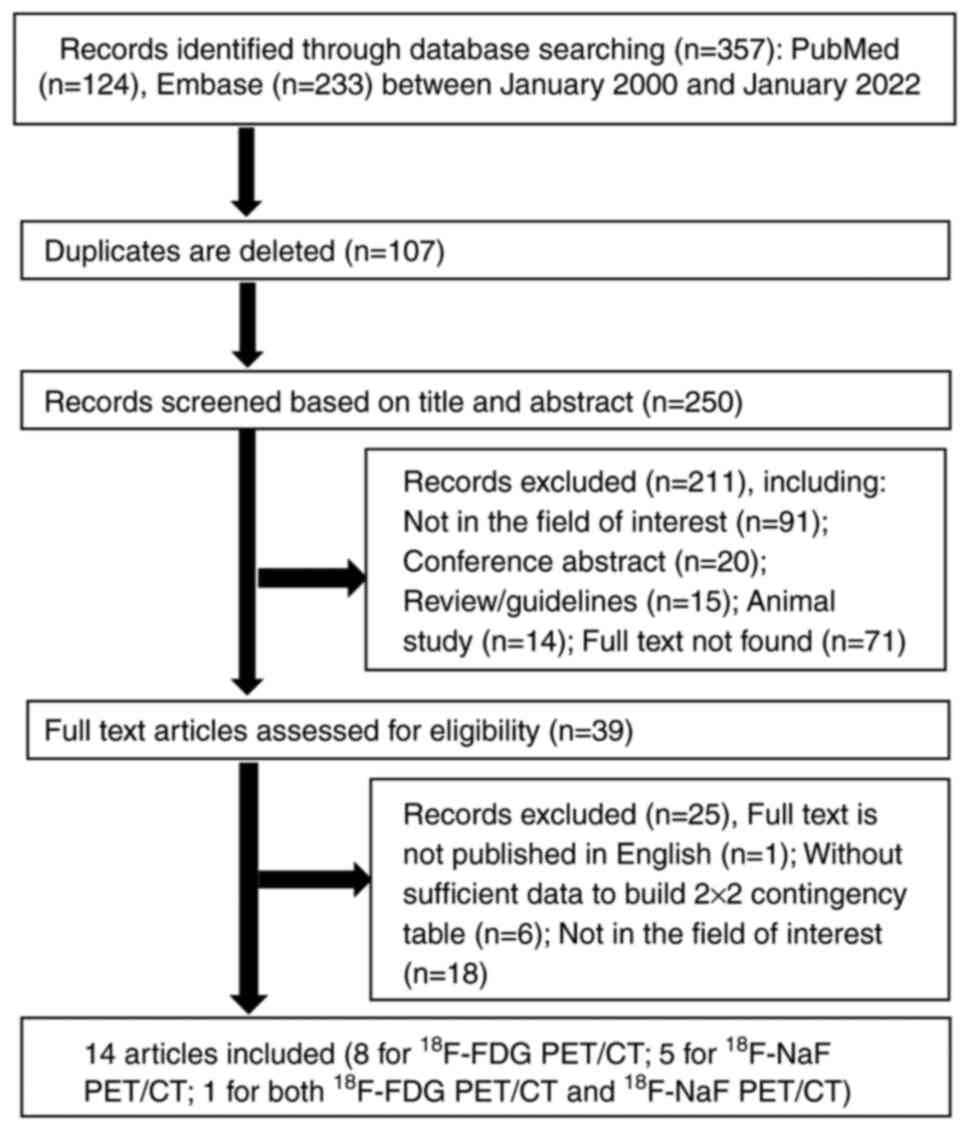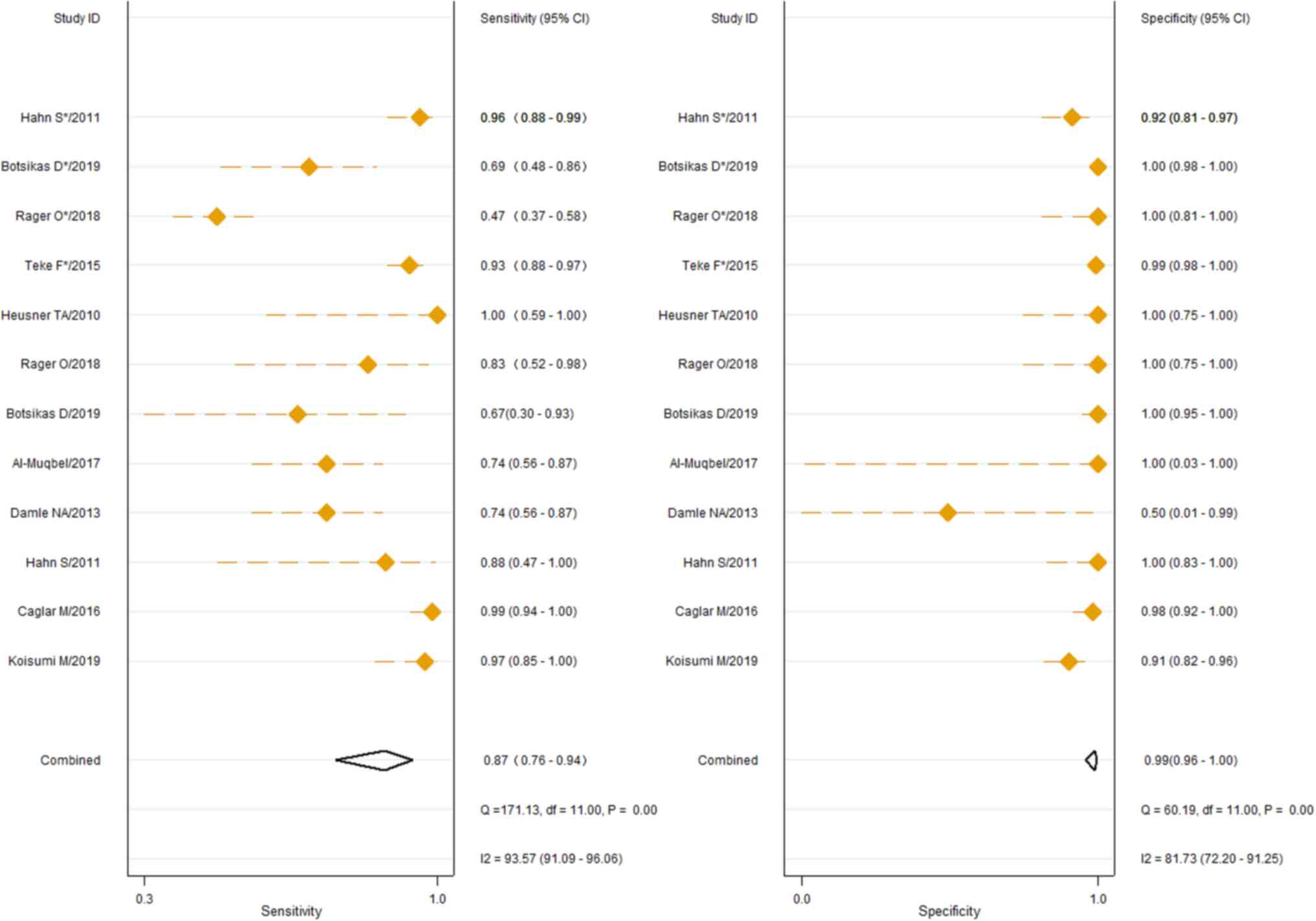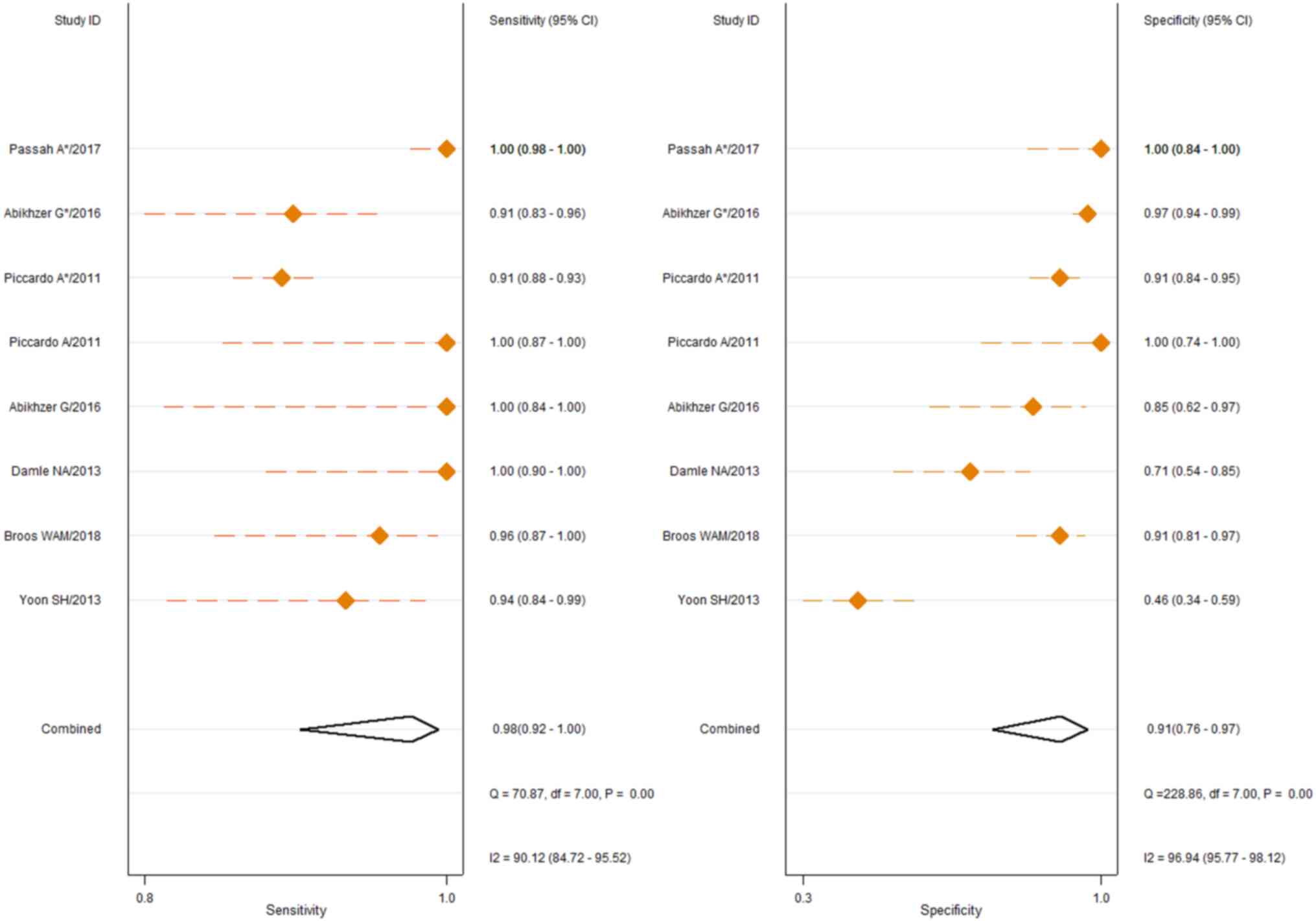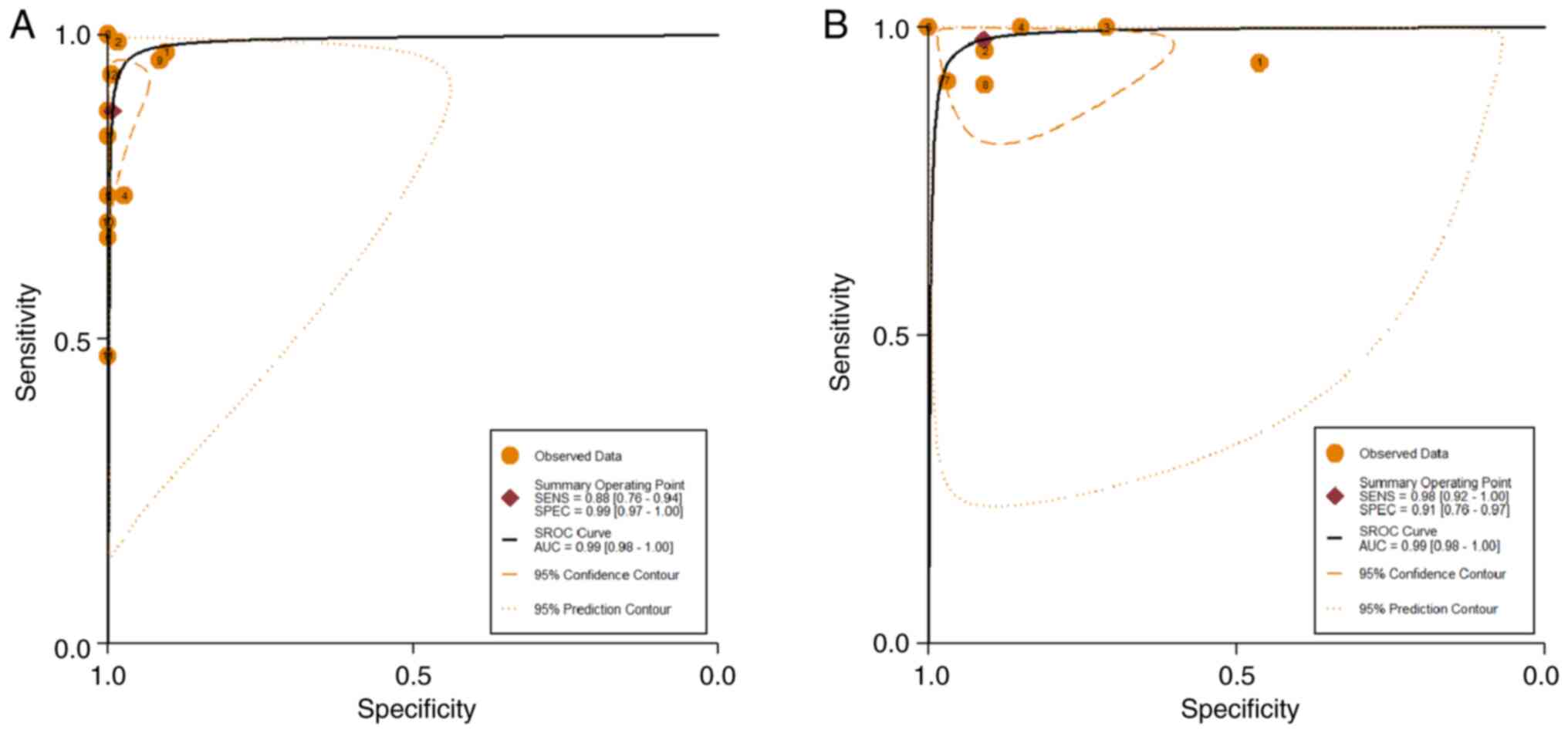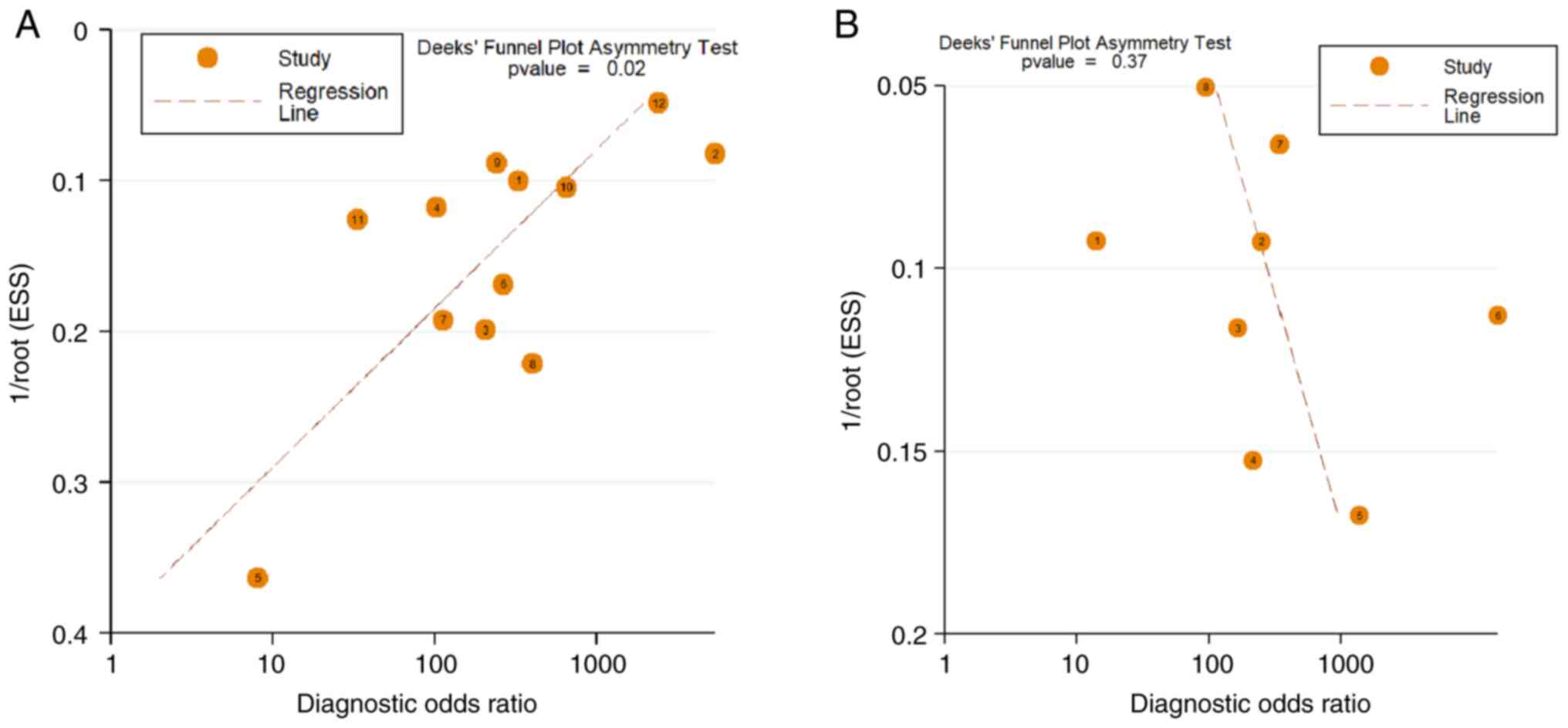|
1
|
Bray F, Laversanne M, Sung H, Ferlay J,
Siegel RL, Soerjomataram I and Jemal A: Global cancer statistics
2022: GLOBOCAN estimates of incidence and mortality worldwide for
36 cancers in 185 countries. CA Cancer J Clin. 74:229–263. 2024.
View Article : Google Scholar : PubMed/NCBI
|
|
2
|
Cook GJ, Houston S, Rubens R, Maisey MN
and Fogelman I: Detection of bone metastases in breast cancer by
18FDG PET: differing metabolic activity in osteoblastic and
osteolytic lesions. J Clin Oncol. 16:3375–3379. 1998. View Article : Google Scholar : PubMed/NCBI
|
|
3
|
Zengel B, Kilic M, Tasli F, Simsek C,
Karatas M, Ozdemir O, Cavdar D, Durusoy R, Bas KK and Uslu A:
Breast cancer patients with isolated bone metastases and
oligometastatic bone disease show different survival outcomes. Sci
Rep. 11:201752021. View Article : Google Scholar : PubMed/NCBI
|
|
4
|
Pantel K and Hayes DF: Disseminated breast
tumour cells: Biological and clinical meaning. Nat Rev Clin Oncol.
15:129–131. 2018. View Article : Google Scholar : PubMed/NCBI
|
|
5
|
Makhoul I, Montgomery CO, Gaddy D and Suva
LJ: The best of both worlds-managing the cancer, saving the bone.
Nat Rev Endocrinol. 12:29–42. 2016. View Article : Google Scholar : PubMed/NCBI
|
|
6
|
Brook N, Brook E, Dharmarajan A, Dass CR
and Chan A: Breast cancer bone metastases: Pathogenesis and
therapeutic targets. Int J Biochem Cell Biol. 96:63–78. 2018.
View Article : Google Scholar : PubMed/NCBI
|
|
7
|
Weigelt B, Peterse JL and van't Veer LJ:
Breast cancer metastasis: Markers and models. Nat Rev Cancer.
5:591–602. 2005. View Article : Google Scholar : PubMed/NCBI
|
|
8
|
Liu T, Cheng T, Xu W, Yan WL, Liu J and
Yang HL: A meta-analysis of 18FDG-PET, MRI and bone scintigraphy
for diagnosis of bone metastases in patients with breast cancer.
Skeletal Radiol. 40:523–531. 2011. View Article : Google Scholar : PubMed/NCBI
|
|
9
|
Cook GJ, Azad GK and Goh V: Imaging bone
metastases in breast cancer: Staging and response assessment. J
Nucl Med. 57 (Suppl 1):27S–33S. 2016. View Article : Google Scholar : PubMed/NCBI
|
|
10
|
Hansen JA, Naghavi-Behzad M, Gerke O, Baun
C, Falch K, Duvnjak S, Alavi A, Høilund-Carlsen PF and Hildebrandt
MG: Diagnosis of bone metastases in breast cancer: Lesion-based
sensitivity of dual-time-point FDG-PET/CT compared to low-dose CT
and bone scintigraphy. PLoS One. 16:e02600662021. View Article : Google Scholar : PubMed/NCBI
|
|
11
|
Garami Z, Hascsi Z, Varga J, Dinya T,
Tanyi M, Garai I, Damjanovich L and Galuska L: The value of 18-FDG
PET/CT in early-stage breast cancer compared to traditional
diagnostic modalities with an emphasis on changes in disease stage
designation and treatment plan. Eur J Surg Oncol. 38:31–37. 2012.
View Article : Google Scholar : PubMed/NCBI
|
|
12
|
Bastawrous S, Bhargava P, Behnia F, Djang
DS and Haseley DR: Newer PET application with an old tracer: Role
of 18F-NaF skeletal PET/CT in oncologic practice. Radiographics.
34:1295–1316. 2014. View Article : Google Scholar : PubMed/NCBI
|
|
13
|
Xiong Z, Deng G, Huang X, Li X, Xie X,
Wang J, Shuang Z and Wang X: Bone metastasis pattern in initial
metastatic breast cancer: A population-based study. Cancer Manag
Res. 10:287–295. 2018. View Article : Google Scholar : PubMed/NCBI
|
|
14
|
Tsuzuki S, Park SH, Eber MR, Peters CM and
Shiozawa Y: Skeletal complications in cancer patients with bone
metastases. Int J Urol. 23:825–832. 2016. View Article : Google Scholar : PubMed/NCBI
|
|
15
|
Damle NA, Bal C, Bandopadhyaya GP, Kumar
L, Kumar P, Malhotra A and Lata S: The role of 18F-fluoride PET-CT
in the detection of bone metastases in patients with breast, lung
and prostate carcinoma: A comparison with FDG PET/CT and 99mTc-MDP
bone scan. Jpn J Radiol. 31:262–269. 2013. View Article : Google Scholar : PubMed/NCBI
|
|
16
|
Al-Muqbel KM, Yaghan RJ, Al-Omari MH,
Rousan LA, Dagher NM and Al Bashir S: Clinical relevance of
18F-FDG-negative osteoblastic metastatic bone lesions noted on
PET/CT in breast cancer patients. Nucl Med Commun. 37:593–601.
2016. View Article : Google Scholar : PubMed/NCBI
|
|
17
|
Gaeta CM, Vercher-Conejero JL, Sher AC,
Kohan A, Rubbert C and Avril N: Recurrent and metastatic breast
cancer PET, PET/CT, PET/MRI: FDG and new biomarkers. Q J Nucl Med
Mol Imaging. 57:352–366. 2013.PubMed/NCBI
|
|
18
|
Liberati A, Altman DG, Tetzlaff J, Mulrow
C, Gøtzsche PC, Ioannidis JP, Clarke M, Devereaux PJ, Kleijnen J
and Moher D: The PRISMA statement for reporting systematic reviews
and meta-analyses of studies that evaluate healthcare
interventions: Explanation and elaboration. BMJ. 339:b27002009.
View Article : Google Scholar : PubMed/NCBI
|
|
19
|
Whiting PF, Rutjes AW, Westwood ME,
Mallett S, Deeks JJ, Reitsma JB, Leeflang MM, Sterne JA and Bossuyt
PM: QUADAS-2: A revised tool for the quality assessment of
diagnostic accuracy studies. Ann Intern Med. 155:529–536. 2011.
View Article : Google Scholar : PubMed/NCBI
|
|
20
|
Deeks JJ: Systematic reviews in health
care: Systematic reviews of evaluations of diagnostic and screening
tests. BMJ. 323:157–162. 2001. View Article : Google Scholar : PubMed/NCBI
|
|
21
|
Deeks JJ, Macaskill P and Irwig L: The
performance of tests of publication bias and other sample size
effects in systematic reviews of diagnostic test accuracy was
assessed. J Clin Epidemiol. 58:882–893. 2005. View Article : Google Scholar : PubMed/NCBI
|
|
22
|
Hahn S, Heusner T, Kümmel S, Köninger A,
Nagarajah J, Müller S, Boy C, Forsting M, Bockisch A, Antoch G and
Stahl A: Comparison of FDG-PET/CT and bone scintigraphy for
detection of bone metastases in breast cancer. Acta Radiol.
52:1009–1014. 2011. View Article : Google Scholar : PubMed/NCBI
|
|
23
|
Broos W, van der Zant FM, Wondergem M and
Knol R: Accuracy of 18F-NaF PET/CT in bone metastasis detection and
its effect on patient management in patients with breast carcinoma.
Nucl Med Commun. 39:325–333. 2018. View Article : Google Scholar : PubMed/NCBI
|
|
24
|
Rager O, Lee-Felker SA, Tabouret-Viaud C,
Felker ER, Poncet A, Amzalag G, Garibotto V, Zaidi H and Walter MA:
Accuracy of whole-body HDP SPECT/CT, FDG PET/CT, and their
combination for detecting bone metastases in breast cancer: An
intra-personal comparison. Am J Nucl Med Mol Imaging. 8:159–168.
2018.PubMed/NCBI
|
|
25
|
Al-Muqbel KM: Bone marrow metastasis is an
early stage of bone metastasis in breast cancer detected clinically
by F18-FDG-PET/CT imaging. Biomed Res Int. 2017:98526322017.
View Article : Google Scholar : PubMed/NCBI
|
|
26
|
Caglar M, Kupik O, Karabulut E and
Høilund-Carlsen PF: Detection of bone metastases in breast cancer
patients in the PET/CT era: Do we still need the bone scan. Rev Esp
Med Nucl Imagen Mol. 35:3–11. 2016.PubMed/NCBI
|
|
27
|
Piccardo A, Altrinetti V, Bacigalupo L,
Puntoni M, Biscaldi E, Gozza A, Cabria M, Iacozzi M, Pasa A,
Morbelli S, et al: Detection of metastatic bone lesions in breast
cancer patients: fused (18)F-Fluoride-PET/MDCT has higher accuracy
than MDCT. Preliminary experience. Eur J Radiol. 81:2632–2638.
2012. View Article : Google Scholar : PubMed/NCBI
|
|
28
|
Heusner TA, Kuemmel S, Koeninger A, Hamami
ME, Hahn S, Quinsten A, Bockisch A, Forsting M, Lauenstein T,
Antoch G and Stahl A: Diagnostic value of diffusion-weighted
magnetic resonance imaging (DWI) compared to FDG PET/CT for
whole-body breast cancer staging. Eur J Nucl Med Mol Imaging.
37:1077–1086. 2010. View Article : Google Scholar : PubMed/NCBI
|
|
29
|
Passah A, Tripathi M, Ballal S, Yadav MP,
Kumar R, Roesch F, Meckel M, Sarathi Chakraborty P and Bal C:
Evaluation of bone-seeking novel radiotracer
68Ga-NO2AP-Bisphosphonate for the detection of skeletal
metastases in carcinoma breast. Eur J Nucl Med Mol Imaging.
44:41–49. 2017. View Article : Google Scholar : PubMed/NCBI
|
|
30
|
Koizumi M, Motegi K and Umeda T: A novel
biomarker, active whole skeletal total lesion glycolysis (WS-TLG),
as a quantitative method to measure bone metastatic activity in
breast cancer patients. Ann Nucl Med. 33:502–511. 2019. View Article : Google Scholar : PubMed/NCBI
|
|
31
|
Abikhzer G, Srour S, Fried G, Drumea K,
Kozlener E, Frenkel A, Israel O, Fogelman I and Kagna O:
Prospective comparison of whole-body bone SPECT and sodium
18F-fluoride PET in the detection of bone metastases from breast
cancer. Nucl Med Commun. 37:1160–1168. 2016. View Article : Google Scholar : PubMed/NCBI
|
|
32
|
Teke F, Teke M, Inal A, Kaplan MA,
Kucukoner M, Aksu R, Urakci Z, Tasdemir B and Isikdogan A:
Significance of hormone receptor status in comparison of
18F-FDG-PET/CT and 99mTc-MDP bone scintigraphy for evaluating bone
metastases in patients with breast cancer: Single center
experience. Asian Pac J Cancer Prev. 16:387–391. 2015. View Article : Google Scholar : PubMed/NCBI
|
|
33
|
Yoon SH, Kim KS, Kang SY, Song HS, Jo KS,
Choi BH, Lee SJ, Yoon JK and An YS: Usefulness of (18)F-fluoride
PET/CT in breast cancer patients with osteosclerotic bone
metastases. Nucl Med Mol Imaging. 47:27–35. 2013. View Article : Google Scholar : PubMed/NCBI
|
|
34
|
Botsikas D, Bagetakos I, Picarra M, Da
Cunha Afonso Barisits AC, Boudabbous S, Montet X, Lam GT, Mainta I,
Kalovidouri A and Becker M: What is the diagnostic performance of
18-FDG-PET/MR compared to PET/CT for the N- and M-staging of breast
cancer. Eur Radiol. 29:1787–1798. 2019. View Article : Google Scholar : PubMed/NCBI
|
|
35
|
Hu X, Li D, Liang Z, Liao Y, Yang L, Wang
R, Wang P and Cai J: Indirect comparison of the diagnostic
performance of 18F-FDG PET/CT and MRI in differentiating benign and
malignant ovarian or adnexal tumors: A systematic review and
meta-analysis. BMC Cancer. 21:10802021. View Article : Google Scholar : PubMed/NCBI
|
|
36
|
Evangelista L, Panunzio A, Polverosi R,
Ferretti A, Chondrogiannis S, Pomerri F, Rubello D and Muzzio PC:
Early bone marrow metastasis detection: The additional value of
FDG-PET/CT vs. CT imaging. Biomed Pharmacother. 66:448–453. 2012.
View Article : Google Scholar : PubMed/NCBI
|
|
37
|
Han S and Choi JY: Impact of 18F-FDG PET,
PET/CT, and PET/MRI on staging and management as an initial staging
modality in breast cancer: A systematic review and meta-analysis.
Clin Nucl Med. 46:271–282. 2021. View Article : Google Scholar : PubMed/NCBI
|
|
38
|
Zhang X, Liu Y, Luo H and Zhang J: PET/CT
and MRI for identifying axillary lymph node metastases in breast
cancer patients: Systematic review and meta-Analysis. J Magn Reson
Imaging. 52:1840–1851. 2020. View Article : Google Scholar : PubMed/NCBI
|
|
39
|
Han S and Choi JY: Prognostic value of
18F-FDG PET and PET/CT for assessment of treatment response to
neoadjuvant chemotherapy in breast cancer: A systematic review and
meta-analysis. Breast Cancer Res. 22:1192020. View Article : Google Scholar : PubMed/NCBI
|
|
40
|
Diao W, Tian F and Jia Z: The prognostic
value of SUVmax measuring on primary lesion and ALN by 18F-FDG PET
or PET/CT in patients with breast cancer. Eur J Radiol. 105:1–7.
2018. View Article : Google Scholar : PubMed/NCBI
|
|
41
|
Krüger S, Buck AK, Mottaghy FM, Hasenkamp
E, Pauls S, Schumann C, Wibmer T, Merk T, Hombach V and Reske SN:
Detection of bone metastases in patients with lung cancer:
99mTc-MDP planar bone scintigraphy, 18F-fluoride PET or 18F-FDG
PET/CT. Eur J Nucl Med Mol Imaging. 36:1807–1812. 2009. View Article : Google Scholar : PubMed/NCBI
|
|
42
|
Grant FD, Fahey FH, Packard AB, Davis RT,
Alavi A and Treves ST: Skeletal PET with 18F-fluoride: Applying new
technology to an old tracer. J Nucl Med. 49:68–78. 2008. View Article : Google Scholar : PubMed/NCBI
|
|
43
|
Schirrmeister H, Guhlmann A, Kotzerke J,
Santjohanser C, Kühn T, Kreienberg R, Messer P, Nüssle K, Elsner K,
Glatting G, et al: Early detection and accurate description of
extent of metastatic bone disease in breast cancer with fluoride
ion and positron emission tomography. J Clin Oncol. 17:2381–2389.
1999. View Article : Google Scholar : PubMed/NCBI
|
|
44
|
Bebbington NA, Zacho HD and Holdgaard PC:
Lesion detection in 18F-sodium fluoride bone imaging: A comparison
of attenuation-corrected versus nonattenuation-corrected PET
reconstructions from modern PET-CT systems. Nucl Med Commun.
43:78–85. 2022. View Article : Google Scholar : PubMed/NCBI
|
|
45
|
Capitanio S, Bongioanni F, Piccardo A,
Campus C, Gonella R, Tixi L, Naseri M, Pennone M, Altrinetti V,
Buschiazzo A, et al: Comparisons between glucose analogue
2-deoxy-2-((18)F)fluoro-D-glucose and (18)F-sodium fluoride
positron emission tomography/computed tomography in breast cancer
patients with bone lesions. World J Radiol. 8:200–209. 2016.
View Article : Google Scholar : PubMed/NCBI
|
|
46
|
Balci TA, Koc ZP and Komek H: Bone scan or
(18)f-fluorodeoxyglucose positron emission tomography/computed
tomography; which modality better shows bone metastases of breast
cancer. Breast Care (Basel). 7:389–393. 2012. View Article : Google Scholar : PubMed/NCBI
|



